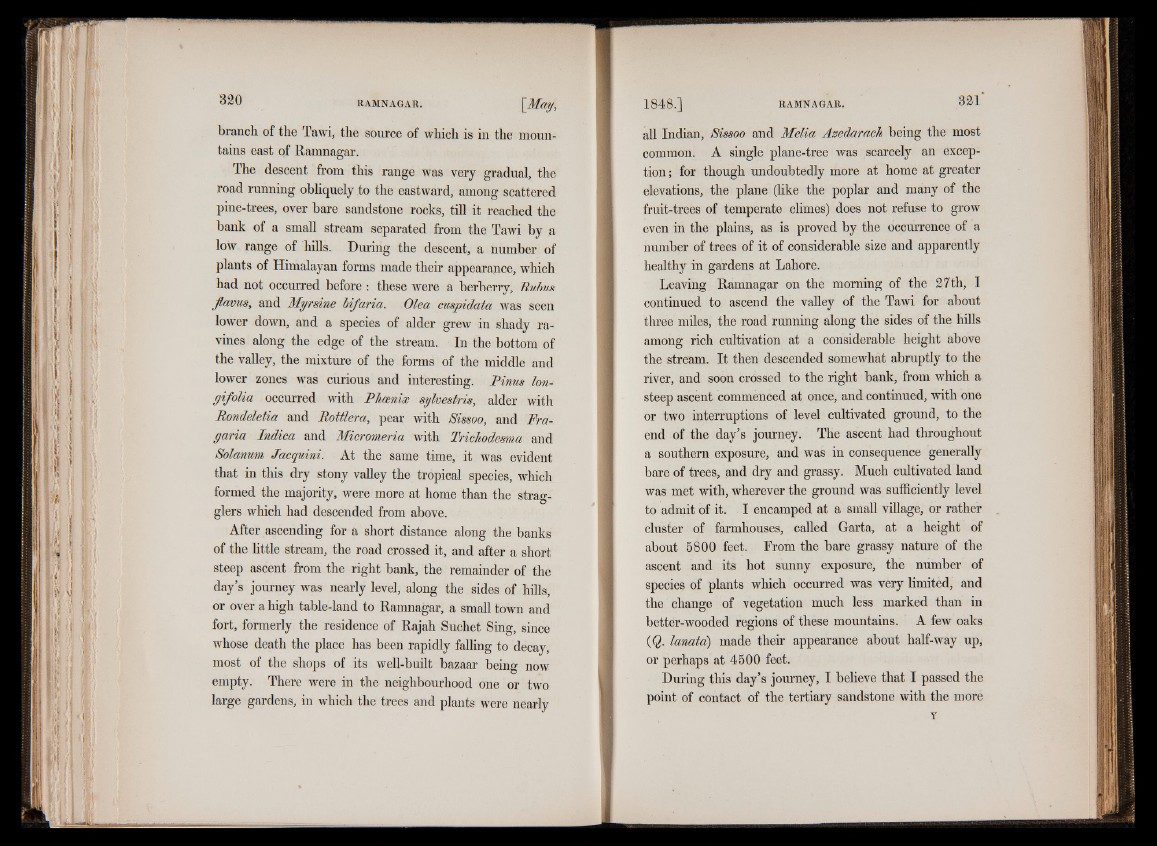
branch of the Tawi, the source of which is in the mountains
east of Ramnagar.
The descent from this range was very gradual, the
road running obliquely to the eastward, among scattered
pine-trees, over bare sandstone rocks, till it reached the
bank of a small stream separated from the Tawi by a
low range of hills. During the descent, a number of
plants of Himalayan forms made their appearance, which
had not occurred before : these were a berberry, Bubus
flavus, and Myrsine bifaria. Olea cuspidata was seen
lower down, and a species of alder grew in shady ravines
along the edge of the stream. In the bottom of
the valley, the mixture of the forms of the middle and
lower zones was curious and interesting. Pirns lon-
gifolia occurred with Phoenix sylvestris, alder with
Bondeletia and Bottlera, pear with Sissoo, and Fra-
yaria Indica and Micromeria with Trichodesma and
Solanum Jacquini. At the same time, it was evident
that in this dry stony valley the tropical species, which
formed the majority, were more at home than the stragglers
which had descended from above.
After ascending for a short distance along the banks
of the little stream, the road crossed it, and after a short
steep ascent from the right bank, the remainder of the
day’s journey was nearly level, along the sides of hills,
or over a high table-land to Ramnagar, a small town and
fort, formerly the residence of Rajah Suchet Sing, since
whose death the place has been rapidly falling to decay,
most of the shops of its well-built bazaar being now
empty. There were in the neighbourhood one or two
large gardens, in which the trees and plants were nearly
all Indian, Sissoo and Melia Azedarach being the most
common. A single plane-tree was scarcely an exception;
for though undoubtedly more at home at greater
elevations, the plane (like the poplar and many of the
fruit-trees of temperate climes) does not refuse to grow
even in the plains, as is proved by the occurrence of a
number of trees of it of considerable size and apparently
healthy in gardens at Lahore.
Leaving Ramnagar on the morning of the 27th, I
continued to ascend the valley of the Tawi for about
three miles, the road running along the sides of the hills
among rich cultivation at a considerable height above
the stream. It then descended somewhat abruptly to the
river, and soon crossed to the right bank, from which a
steep ascent commenced at once, and continued, with one
or two interruptions of level cultivated ground, to the
end of the day’s journey. The ascent had throughout
a southern exposure, and was in consequence generally
bare of trees, and dry and grassy. Much cultivated land
was met with, wherever the ground was sufficiently level
to admit of it. I encamped at a small village, or rather
cluster of farmhouses, called Garta, at a height of
about 5800 feet. From the bare grassy nature of the
ascent and its hot sunny exposure, the number of
species of plants which occurred was very limited, and
the change of vegetation much less marked than in
better-wooded regions of these mountains. A few oaks
(Q. lanata) made their appearance about half-way up,
or perhaps at 4500 feet.
During this day’s journey, I believe that I passed the
point of contact of the tertiary sandstone with the more
Y